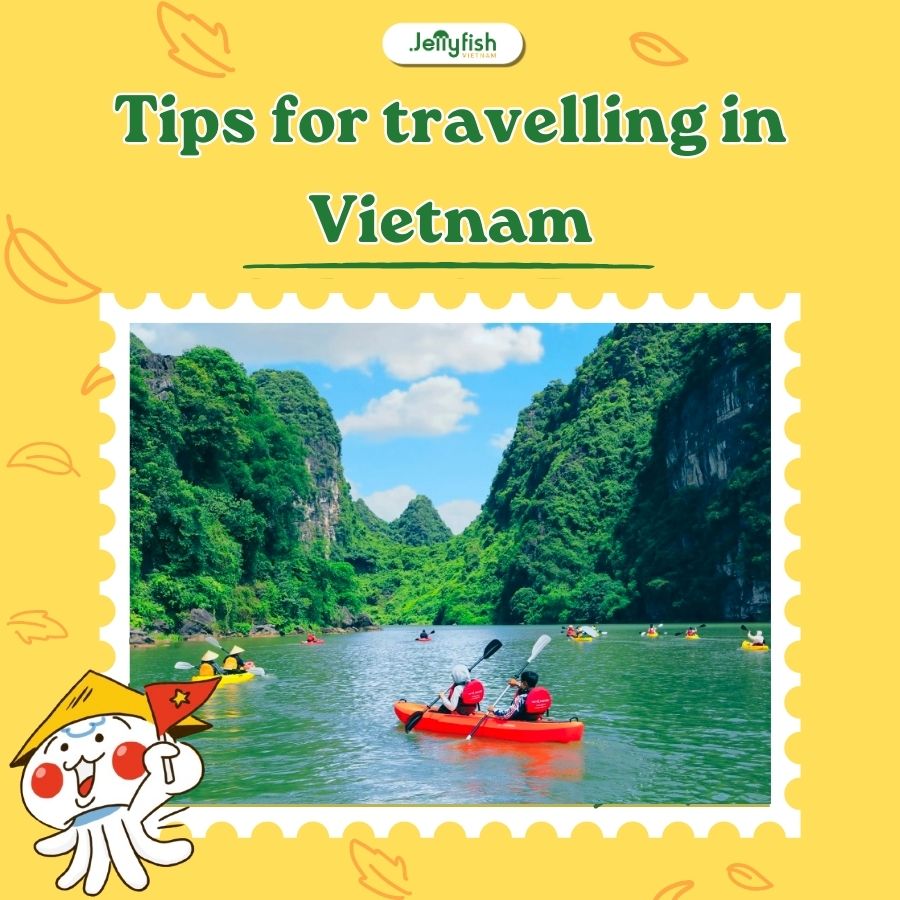Tips for travelling in Vietnam are essential for anyone preparing to explore this vibrant and culturally rich Southeast Asian destination. From the chaotic charm of Ho Chi Minh City to the quiet beauty of Ha Long Bay, Vietnam is full of unforgettable experiences — but knowing how to navigate its customs, transport, and cuisine will make your journey smoother and more enjoyable. In this guide, Jellyfish will provide the most useful travel tips for Vietnam, helping you prepare with confidence.
1. Visa and entry: know before you go
Before you arrive in Vietnam, make sure you understand the visa process. This is one of the most important tips for travelling in Vietnam, especially for first-timers.

- Most travelers need a visa — check if your country qualifies for visa exemption.
- The easiest method is applying for an e-visa (valid for 90+ countries).
- Apply through the official government site
- Always carry a printed copy of your e-visa to show at immigration.
2. Learn basic Vietnamese phrases
Speaking even a few words of Vietnamese can make a big difference in how locals treat you — and in how smoothly your trip goes.
- Xin chào – Hello
- Cảm ơn – Thank you
- Bao nhiêu tiền? – How much?
- Tôi muốn gọi món – I’d like to order food
- Nhà vệ sinh ở đâu? – Where is the restroom?

Tip: Enroll in a short Vietnamese language course with Jellyfish to travel more confidently.
3. Transportation: How to Get Around Safely
Vietnam’s traffic can feel overwhelming at first, but once you understand your options, it becomes easier to move around.
- Use Grab (similar to Uber) or Be for motorbike and car rides.
- Domestic flights are affordable and save time for long-distance travel.
- Trains offer scenic routes (e.g., Hanoi – Da Nang), but buses are cheaper.
- If you ride a motorbike, make sure you have an international driving permit and wear a helmet.

4. Safety tips for travelling in Vietnam
Vietnam is generally safe, but like any destination, you should take precautions to protect yourself and your belongings.
- Keep your phone and wallet secure, especially in crowded markets.
- Avoid carrying large amounts of cash.
- Be cautious when crossing busy streets — walk slowly, confidently, and let vehicles adjust to you.
- Use hotel safes and avoid sharing your travel plans with strangers.
5. What to pack for Vietnam
Vietnam has different climates depending on the region and time of year. Pack smart to be ready for every situation.
- Lightweight, breathable clothes for hot weather.
- A light jacket or sweater for cool evenings in the north.
- Raincoat or umbrella (especially from May to October).
- Sunscreen, insect repellent, and a travel adapter (Type A, C, or D, 220V).
6. Currency and payments
Understanding how money works in Vietnam will help you avoid confusion and stay on budget.
- The currency is Vietnamese đồng (VND) – don’t be overwhelmed by all the zeros.
- Use apps like XE Currency to track exchange rates.
- ATMs are widely available and usually offer better rates than currency exchange counters.
- Credit cards are accepted in hotels and big restaurants, but cash is essential for street food, taxis, and markets.

7. Vietnamese street food
Vietnamese cuisine is world-famous, and street food is a big part of the experience. However, if you’re not careful, your stomach might not thank you.

- Always eat where it’s busy — high turnover means fresher food.
- Avoid raw vegetables and ice if you have a sensitive stomach.
- Wash your hands or use hand sanitizer before eating.
- Must-try dishes: Phở, Bún chả, Bánh mì, Gỏi cuốn, and Cà phê sữa đá.
8. Respect local customs and culture
Understanding Vietnamese etiquette helps you avoid misunderstandings and connect more deeply with locals.
- Remove shoes before entering someone’s home or certain temples.
- Dress modestly when visiting religious sites.
- Avoid touching people’s heads — it’s considered disrespectful.
- Public displays of affection are frowned upon in rural areas.
9. Internet and connectivity
Staying connected in Vietnam is easy and affordable.
- Buy a local SIM card from providers like Viettel, Mobifone, or Vinaphone.
- Data plans are cheap and reliable (great for maps and translation apps).
- Wi-Fi is widely available in hotels, cafés, and even some buses.

10. Travel insurance and emergency prep
One of the most overlooked but important tips for travelling in Vietnam is having a backup plan.
- Purchase travel insurance that includes health coverage and motorbike accidents if you plan to ride.
- Carry a photocopy of your passport and visa separately from the originals.
- Save emergency numbers, including your embassy or consulate.
Know more: Six places to learn Vietnamese in Hanoi – the capital of Vietnam
Final Thoughts – Travel Smarter with These Tips for Travelling in Vietnam
With stunning landscapes, delicious food, and welcoming people, Vietnam offers unforgettable travel moments. But having the right knowledge can be the difference between a good trip and a great one. These tips for travelling in Vietnam will help you stay safe, save money, and experience the country with confidence and cultural respect.
Jellyfish is here to help you go beyond being just a tourist. Whether you want to speak basic Vietnamese, understand street signs, or feel more connected to locals, our language courses are designed for travelers like you.
For more information and free consultancy, please fill the form below! We will reach out to you!
👉👉 Learning Vietnamese – Jellyfish Vietnam
✦ Hotline: 096 110 6466
✦ Head office: 1st Floor, Web3 Tower, 4 Duy Tan, Cau Giay, Ha Noi
✦ Branch office: 2rd Floor, SH5.11 Vinhomes Marina, Vinh Niem, Le Chan, Haiphong
✦ Head office in Japan: 4F Westhill Building, Nishigotanda 2-24-4, Shinagawa, Tokyo, Japan


